CANYON VIEWS

VOL.30, NO. 1 WINTER 2023 A PUBLICATION OF GRAND CANYON CONSERVANCY
Canyon Views is published by Grand Canyon Conservancy (GCC). As the official philanthropic and collaborative partner of Grand Canyon National Park, GCC’s mission is to inspire generations of park champions to cherish and support the natural and cultural wonder of Grand Canyon.

For more information about Grand Canyon Conservancy, please visit grandcanyon.org.
Board of Directors:
Mitchell Walker, Board Chair; Shantini Munthree, Board Vice Chair; Lizabeth Ardisana; Ann Becker; Randall Brown; Awenate Cobbina; Jason Coochwytewa; Aaron Craft; Ann West Figueredo; Nigel Finney; Deborah Gage; Charlie Galbraith; Alejandra Lillo; Carissa Rollins; Rich Rudow; Mick Rusing; Stephanie Sklar; Stan Sutherland; Merl Waschler; Tyson Winarski
Chief Executive Officer:
Theresa McMullan
Chief Philanthropy Officer:
Danielle Segura
Director of Marketing & Communications and Canyon Views Editor:
Mindy Riesenberg
Graphic Design:
Charla Keyaanie
Printing: Prisma
Copyright © 2023 Grand Canyon Conservancy
Cover photo courtesy of Michael Quinn
From the CEO
Grand Canyon Conservancy
P.O. Box 399
Grand Canyon, AZ 86023-0399
(800) 858-2808
grandcanyon.org
DEAR FRIENDS,
Millions of people visit Grand Canyon National Park each year, yet no two experiences are the same. I’ve hiked in the canyon more times than I can count, and every outing was unforgettable, yet distinct.
You may have visited Tim’s Hut, also known as the Tipoff Shelter on the South Kaibab Trail. It was installed on Halloween in 2019 and provides shade, which may seem like a simple thing, but on this trail, where there is no potable water and temperatures can climb rapidly, shade is a huge deal.

On a hike last April, temperatures were surprisingly high. As I approached the Tipoff, I could see a massive crowd. When I arrived, I found over 50 people gathered in and around Tim’s Hut, the youngest carried on her dad’s back.
I’ll admit I was a little overheated and somewhat cranky. I was looking forward to a nice rest in the shade, and here were ALL these people. But I soon observed that they were sharing snacks, hints for the path ahead, and offering a seat to those who had just arrived. There was an air of kindness, and that’s what I’ve seen every time I’ve returned to this special spot.
I never met Tim, but I learned from his parents, Rob and Mary Bricker, who funded this structure in his memory, that he was a gentle soul. His obituary said, “Tim was a loyal and kind-hearted friend who many have described as their ‘first friend’ in whatever situation they found themselves.”
This issue of Canyon Views focuses on the visitor experience. I hope that when you visit Grand Canyon, your travels will take you someplace special. Whether you seek inspiration from the views, the quiet and the solitude of the backcountry, or the thrills of a river trip, I hope you experience kindness, as I’ve found at Tim’s Hut.
Thanks for spending a little time with Canyon Views.
Theresa McMullan Chief Executive Officer
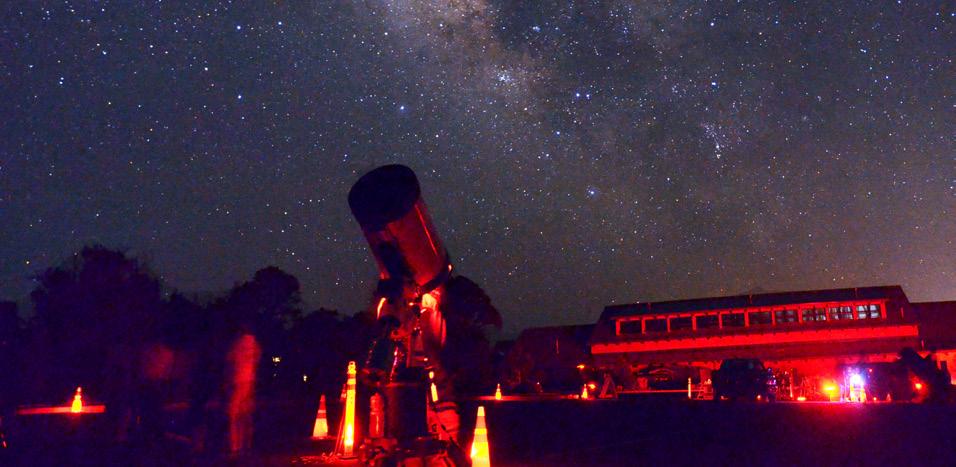




18 02 A Message from Ed 04 Loving Parks to Death? Managing Visitor Expectations 08 Corridor Working Group: A Model for Cross-Collaboration 10 Managing Solitude and Beauty 12 Groundbreaking Visitor Survey Sheds Light on Key Challenges 18 The Canyon is Listening: Á-mi-i-evyo, “Yes, I hear you!” 20 News and Updates 24 Assessing Juniper-Woodland Health in Grand Canyon National Park 26 Take a Journey of Discovery with the Field Institute 27 Artist and Astronomer in Residence Updates 30 Member Spotlight: Lynn and Dave Rahn 32 Become a Grand Guardian 33 Shop Grand Canyon Conservancy In
Issue 04 10 24 27
this
A Message from Ed
By Ed Keable, Superintendent, Grand Canyon National Park
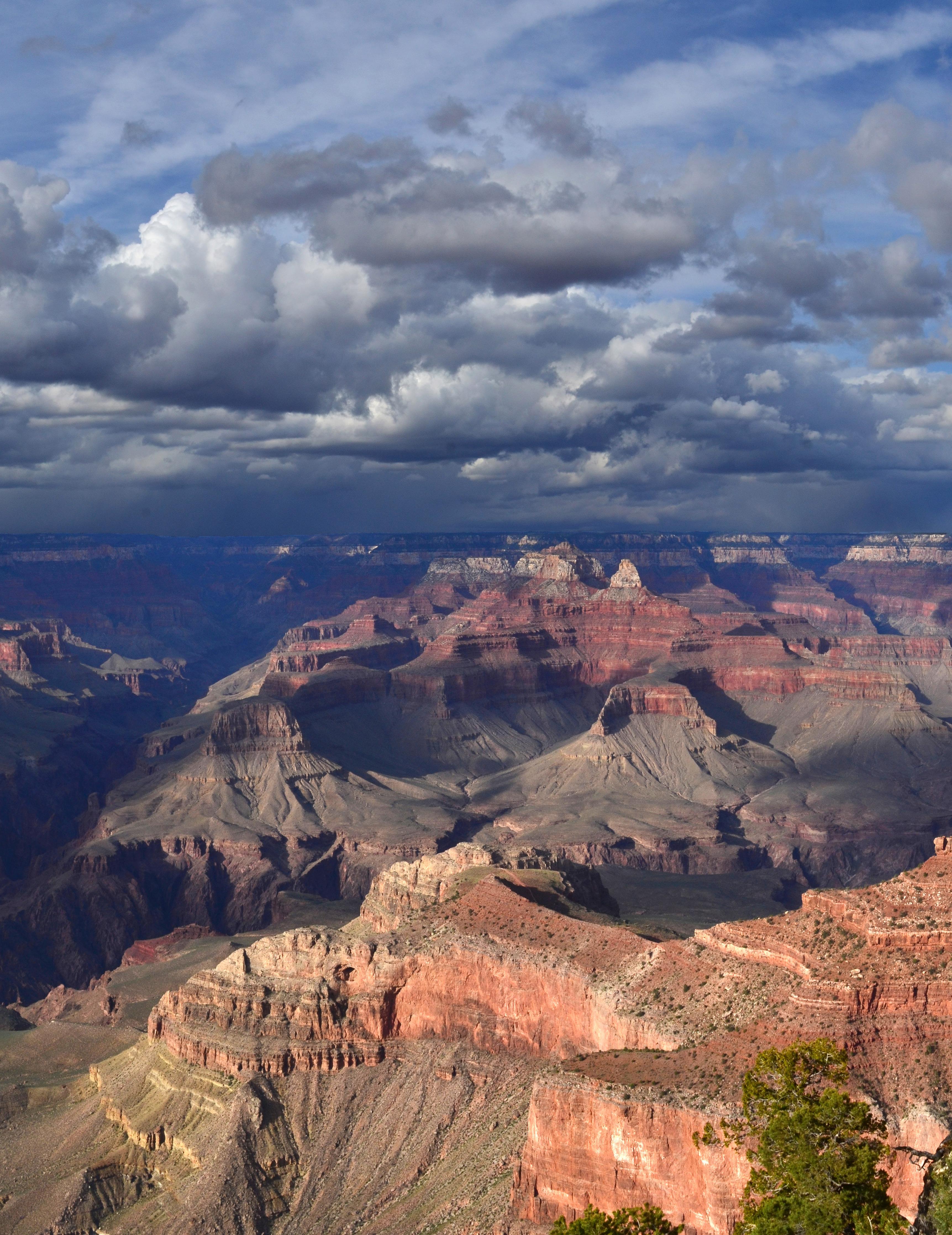
Grand Canyon National Park (GRCA) is a complex place. In addition to containing seven ecosystems, millions of years of geologic history, thousands of years of human history, an aging infrastructure, and a changing environment during the Millennial Drought, GRCA receives millions of visitors a year.
The National Park Service (NPS) mission is first and foremost the conservation of the natural and cultural resources (the “wild life and historic objects”) that set these special places apart from other lands. At the same time, we are charged with providing for the enjoyment, education, and inspiration of this and future generations. So, this complex mission means we, as park managers and stewards, need to balance our preservation with the increasing challenges of visitation.
Anticipating and meeting the needs of our millions of visitors is one of our mission requirements for the NPS and GRCA. But it is also more than
a mission requirement, it is a moral duty. This responsibility presents opportunities for both creativity and caution as we navigate the future of how we manage the park.
We are therefore intentional about planning for how we meet visitor needs now and into the future. In this issue of Canyon Views, you will learn about some of the visitor use planning efforts we have underway at GRCA, including efforts to manage visitor expectations, to understand better visitor use patterns, and to consider visitor use issues at one of our more remote locations, Tuweep.
This issue of Canyon Views also has articles about Indigenous perspectives on respecting the land, Juniper mortality, and managing the Inner Canyon from a cross disciplinary effort. Understanding these things should help you to understand the canyon better, helping to enhance your next visitor experience here. We cannot manage the vast and diverse resources of Grand Canyon without the viewpoints
and energies of a diverse group of staff and partners. These articles showcase some of these efforts.
You will also read about some of the great work Grand Canyon Conservancy (GCC) is doing to support the park’s work to meet our visitors’ needs. The reintroduction of the GCC Field Institute is a huge benefit to our visitors. So, too, is GCC’s Artist and Astronomer in Residence programs. Both programs are rich with educational opportunities that visitors long remember from their visits to GRCA.

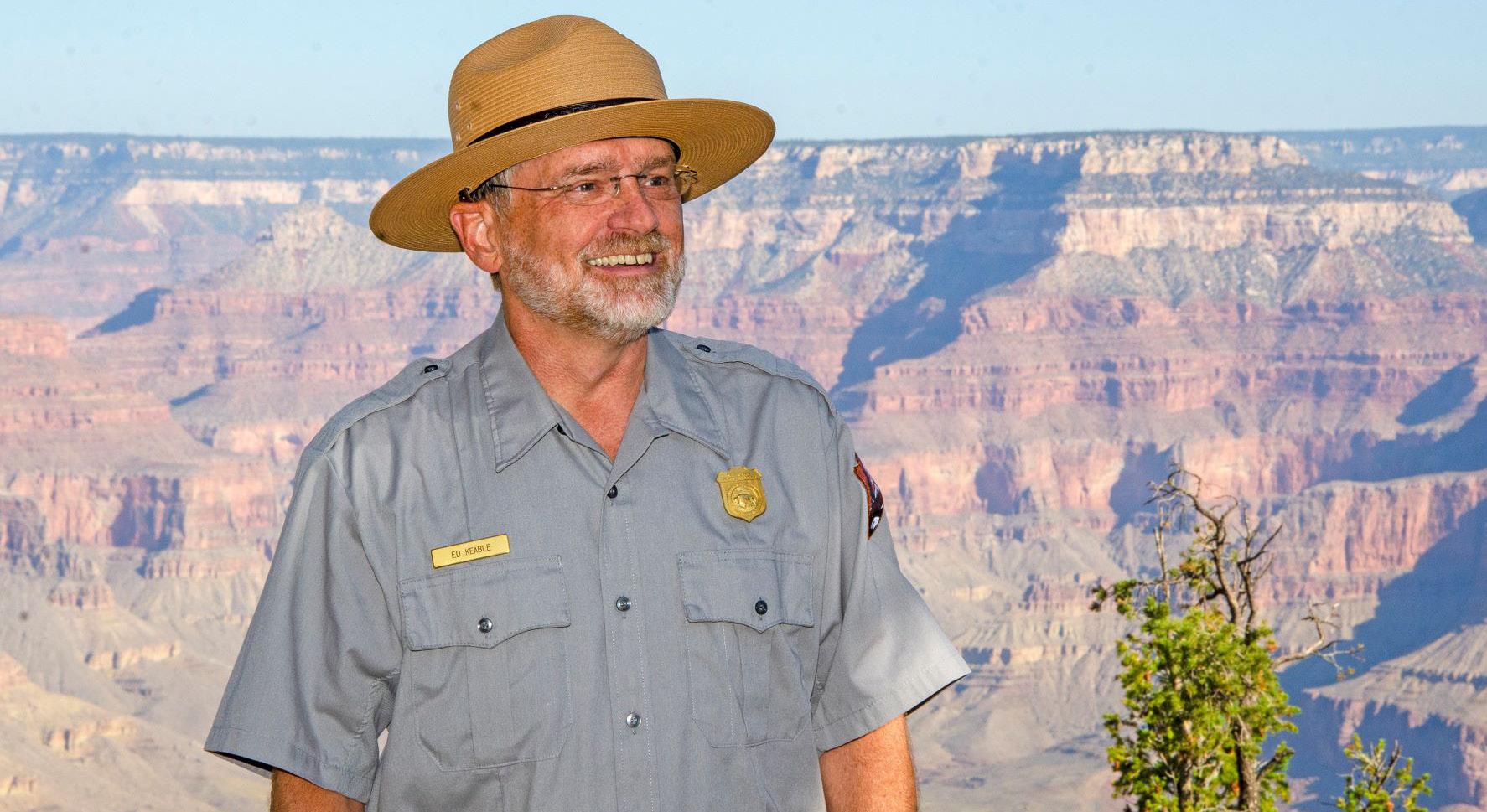
Thank you for your interest in GRCA. Thank you for your support of GCC. I have often observed that I cannot manage GRCA without GCC. Your support of GCC helps GRCA meet our visitor needs.
 Photos
Photos
courtesy NPS
Loving Parks to Death? Managing Visitor Expectations
By Kelly Timmerman,
National parks hit the headlines and social media forums over the past few summers for implementing day use reservation systems in response to long lines that formed at park entrance stations and overcrowding at popular park areas. Parks throughout the United States began using the systems for a variety of reasons related to increases in visitation, some of it because of the COVID-19 pandemic. Outdoors, and by inference, National Parks, provided a safe outdoor space to gather and get out of your house.
For over 100 years, Grand Canyon National Park visitors have enjoyed diverse recreational experiences, from natural beauty and wonder to solitude and challenge. Grand Canyon Conservancy members, with long canyon relationships, probably have a tale or two to share about their own observations and experiences regarding the increased use and popularity at the park especially leading up to the National Park Service (NPS) Centennial.

Reservations, or managed use access systems, are an example of a management tool superintendents can consider using to adhere to the NPS mission to balance the impacts of overcrowding and overuse at parks. The NPS mission directs park managers to provide visitors opportunities to enjoy a park’s natural and cultural resources without allowing that enjoyment to impair or fundamentally and irreparably damage park resources and values. To carry out this important mission, park units employ a Visitor Use Management (VUM) planning process to protect experiences and natural and cultural resources for generations to come.
For the NPS, VUM is a proactive and adaptive process that allows us to manage characteristics of visitor use and the natural and managerial setting using a variety of strategies and tools to achieve and maintain desired resource conditions and visitor experiences.
Taking a proactive approach means that park specialists are gathering information and designing management strategies to anticipate potential problems and take steps to prevent them before they arise. The goal is to prevent, rather than react to, irreversible resource and experience degradation.
It’s difficult to plan for the unknown. By monitoring the conditions of resources and visitor experiences and comparing those to defined desired resource conditions, park managers can implement measures to influence visitor use patterns or adjust management strategies to better meet desired conditions in the future.
Desired conditions are aspirational statements describing the resource conditions, visitor experiences and opportunities, and facilities and services that park managers strive to achieve and maintain for a particular area. They may be descriptive of an area as it exists currently, or they can present a desired future vision to work towards.
Outdoor Recreation Planner, Grand Canyon National Park
Photos in this story courtesy NPS
Desired Conditions for Grand Canyon
The park has a portfolio of management plans covering many topics which guides park manager’s decisions. The two central documents that are the backbone for planning are the park’s 1995 General Management Plan and 2017 Foundation Document. The General Management Plan describes a wide range of desired conditions for visitor experiences in different areas of the park.
Desired conditions for the South Rim developed areas include diverse opportunities to view the canyon through direct access to the rim, where panoramas of the canyon provide the park’s aesthetic, inspirational, and emotional appeal. While accommodating many visitors, the South Rim experience should include minimizing dense crowds, interpreting and maintaining the integrity of extensive cultural resources, and encouraging alternative transportation options. Visitors should be able to experience solitude in natural settings as well as
social exchange in developed areas.
Those conditions contrast with the desired conditions identified for the North Rim developed areas. The North Rim experience is focused on enjoying the serene, natural environment and sweeping canyon views with a relaxed, uncrowded feeling. The North Rim should maintain a low-key and uncrowded atmosphere that offers visitors opportunities to be intimately involved with the environment. Visitors should be able to experience natural sights and sounds with little or no intrusion from other people in many areas of the North Rim. A subdistrict of the North Rim, Tuweep, is identified as a unique remote area that is still accessible by car, with desired conditions of an uncrowded, semi-primitive experience that is dominated by nature and solitude.
The corridor trails are the main transportation routes for most visitors into the inner canyon. Their desired conditions contrast with trails found in the more primitive and wilderness zones of the park. Within the corridor trail area, rustic
facilities provide for visitor safety and reduce environmental impacts. Mules carrying visitors and hauling supplies into the canyon are a part of this historic visitor experience. As on the South Rim, while the Cross Canyon Corridor can accommodate larger volumes of people, park staff works to minimize feelings of crowding, visitor use conflicts, and resource impacts. Beyond the corridor trails, over 90 percent of the park is proposed wilderness, offering visitors opportunities for solitude and primitive recreation where wilderness values and character are primary. These desired conditions do not specify how an area will be managed. Determining management actions is the adaptive part of the management process, and these actions are continually reassessed for effectiveness through monitoring. Management actions include a wide variety of VUM strategies and tools, ranging from minimally invasive and passive approaches, such as education, restoration work, and design changes, to limited permit systems requiring active management and enforcement.

5
Applying VUM at Grand Canyon

Planning is a continuous cycle, and one way park leaders are supporting these efforts is by adding key staff in specific program areas. Park managers have added a policy and program planner, transportation community planner, and outdoor recreation planners. The staff in these positions will contribute to VUM and other park planning efforts with plans, research, and monitoring. Staff are currently working to develop a list of priority planning efforts along with the proposed staffing and timeline to complete them.
There’s currently one pilot management action being utilized at the park. A new day-use permitting
system was implemented at Tuweep in July. The management action follows a series of more minimal actions that did not change visitor use patterns enough to meet desired conditions. Park staff are monitoring the data from the pilot program to learn more about high visitation and commercial transportation patterns there to refine and enhance the overall visitor experience and improve public information resources. (Read more about this program on page 10.)
Park staff are also studying the Cross Canyon Corridor. Over many decades, staff have studied visitor experience and use of the corridor trails seeking to answer these questions: who are our visitors, where are they going, what are they doing, what sort of impacts are they having on park resources, and
are these visitors having the desired experience they seek?
As park visitation has increased over the past few decades, so has the use of the corridor trails and associated human impacts to resources and visitor experience. The impacts have included crowding, excess trash, overburdened composting toilets, trampled vegetation, and trail surface erosion.
An interdisciplinary group called the Corridor Working Group formed with staff representing various park divisions to collaboratively research and discuss those questions. Together this group is developing adaptive management ideas and actions to support visitor recreation experiences that meet desired conditions. (Learn more about this group on page 8.)
6 | CANYON VIEWS
A concept that continues to be difficult to mitigate is the consequences of hikers unprepared for the desert heat, remoteness, and strenuousness of the backcountry hiking experience. Beyond health and safety concerns for visitors and staff, increased Search and Rescue activity taxes park resources, diverting helicopter flights scheduled for maintenance, monitoring, and other essential park activities to real life and death situations. Through extensive monitoring and study of the problem, the Preventive Search & Rescue (PSAR) program developed updated educational materials and messaging to better target the type of behavior that puts visitors most at risk. GCC has been a major supporter of the PSAR program and many
GCC members have volunteered to assist park staff hiking the inner canyon trails carrying messages like “be prepared and hike smart.” The Corridor Working Group is working to implement these and other strategies to meet our desired conditions for the visitor experience along the corridor trails.

Going forward, the Corridor Working Group is looking forward to working through both the challenges and opportunities for VUM presented by the replacement of the aging transcanyon waterline. The project will require a coordinated effort to adapt existing management strategies to changing conditions along the corridor trails during the construction phase. Over the next few years, park managers foresee the need to
implement additional monitoring activities and explore temporary management action options to understand their impact on desired conditions for visitors and resources.
The upcoming infrastructure improvements will provide park managers an opportunity to step back and assess VUM across the park. Over the next few years, we hope to be able to better assess visitor needs and experiences and how we can realize the desired conditions for the longterm preservation of park resources and visitor experiences.
7
Corridor Working Group: A Model for Cross-Collaboration
Millions of people visit Grand Canyon National Park each year, enjoying its massive vistas, unique geology, and cultural history. Far fewer people venture into the depths of the canyon, but those who do benefit from the Corridor Working Group, a cross-disciplinary team made up of representatives from multiple areas of the park.
“The Corridor Working Group is a great model of cross-divisional collaboration,” says Park Ranger Elyssa Shalla. “Any project below the rim is inherently more complicated than any other in the park, and this group
identifies which projects need to get done and how to make them happen.”
Representatives to the group include staff from the divisions of: Visitor and Resource Protection; Interpretation and Resource Education; Science and Resource Management; Facility Management and Engineering; Planning, Environment, and Projects; and Commercial Services. They are tasked with developing management strategies for Corridor Day Use and Rim-to-Rim Activities as well as projects like signage, housing, water projects, campground rehabilitation, and more.
“What’s really cool about this group is that it covers quite a few levels of the organization, from field level supervisors to division chiefs,” says Shalla. “It allows for information sharing and different perspectives.”
Being able to share different perspectives from the field all the way up to leadership helps the park come up with better solutions to issues in the canyon.
“We talk about the issues,” says Shalla. “As a ranger, I share what we’re dealing with every day on the ground, giving those who are higher

8 | CANYON VIEWS
Photo courtesy NPS
up an in-depth view of what we need assistance and support with.”
One of the projects the group works on is addressing deferred maintenance through volunteers. With the assistance of volunteers from the Grand Canyon Hikers and Backpackers Association, the group has now re-painted every single ranger station and bunkhouse in the corridor.


The group also does ongoing work on signage in the corridor, with special emphasis being placed on updating maps that say Indian Garden with the new name of Havasupai Gardens. Interpretive signage is being overhauled by the group to have up-to-date perspectives on science and cultural heritage. Grand Canyon Conservancy (GCC) funds support the replacement of this signage.
GCC also partnered with the Corridor Working Group in 2019 on the development of a shade structure at the Tipoff area off the South Kaibab Trail. And the GCC-funded Preventive Search and Rescue program works with the group to make sure they’re getting the right messaging to visitors about hiker safety.

The Corridor Working Group tries to do two site visits as a team in the corridor each year, and Superintendent Ed Keable has been joining them.
“We’ve been so excited,” says Shalla. “Superintendent Keable hikes in with us and is eager to be part of the conversation. He supports us and follows up on projects, holding us accountable.”
“Because of this group, whenever there is a project, being able to have multiple perspectives always makes the outcome better!” she says.
9
Right photo courtesy NPS Tipoff Shade Structure, photo by Mindy Riesenberg
Managing Solitude and Beauty
Tuweep is one of Grand Canyon National Park’s most remote places. Located off the North Rim in the western part of Grand Canyon, the closest towns are Fredonia, AZ and Kanab, UT. To get there, visitors drive three hours on a rough unpaved road. It takes dedication to visit.

“It’s a special spot,” says Todd Seliga, Tuweep’s Park Ranger. “It’s telecomfree, rustic, and remote. There are very few places like it in the world.”
This unique place, however, has lured more and more people over the years, requiring the park to implement visitation management tactics to help mitigate overcrowding and noise levels. Large groups of up to 80 vehicles were coming in at one time, creating traffic jams leading out to the campground and making it a challenge for visitors to enjoy their trip.
“We couldn’t change the number of people coming in, but we could change the number of cars,” says Seliga. “So, after working with other park partners and agencies, we implemented a host of updates to manage visitation.”
This included extensive messaging by Grand Canyon National Park, Grand Canyon Parashant National Monument, the Arizona Strip District Office of the Bureau of Land Management, and Pipe Spring National Monument at visitor centers, on websites, and through bulletins, which helped decrease some of the excessively large groups. But it wasn’t enough.
“We did the mitigation efforts but were still getting large vehicle convoys,” says Seliga.
The park also did an informal soundscape study and found that the
vehicles arriving in Tuweep weren’t meeting decibel thresholds. A whisper is about 30 dB, normal conversation is about 60 dB, and a motorcycle engine running is about 95 dB. Noise above 70 dB over a prolonged period may start to damage hearing. Many vehicles manufactured for off-highway use couldn’t meet the 60 dB threshold. So, the park and its partners did even more messaging around this issue.
“We also had to develop better messaging to deal with unprepared people who weren’t aware of safety considerations, like weather, tires, when to travel, and proper trip planning,” says Seliga.
In spring 2022, Grand Canyon National Park conducted civic engagement to seek comments on implementing a three-year pilot advance day-use reservation system to manage visitation to the Tuweep
Photos courtesy NPS
Visitor Use Area, and in June 2022, the system was launched on Recreation.gov. It enables the park to facilitate the management of the number of people and vehicles entering Tuweep and allows visitors to easily secure reservations online and plan a safe visit to this remote location by providing preparation materials.
The goal is to preserve the character of Tuweep as an uncrowded, rustic, and remote experience that is dominated by nature and solitude.


Seliga says he’s already seen good results. “It’s so user-friendly,” he says. “The public can see everything online, agree to the elements they need to understand, and choose their visitation days, which is already helping us to smooth out attendance so that ‘spikes’ in attendance no longer occur.”
He says that although people don’t want to see more regulation or steps involved in visiting the park, it’s important to remember the value of the area.
“With planning, we can still allow folks to enjoy and experience Tuweep,” he says. “It’s the people, the history, the community that makes it feel so important to everyone. It’s a unique spot where you may only hear the wind. This system allows people to experience that, just in a managed way.”

Groundbreaking Visitor Survey Sheds Light on Key Challenges
By John Bates
Asone of America’s premier national parks, a UNESCO World Heritage Site, and one of the seven natural wonders of the world, Grand Canyon is a popular destination whose spectacular scenery, geologic marvels, diverse ecosystems, iconic wildlife, and extensive Indigenous history draw visitors from around the globe. Since Grand Canyon National Park was created in 1919, visitation has steadily increased—raising concerns that this special place is at risk of being loved to death.
Between 2010 and 2019, the number of people visiting Grand Canyon National Park rose by 36 percent to more than 6 million annually, with 90 percent of visitors choosing to recreate in the popular South Rim area that features historic hotels, two campgrounds, five trails leading to the Colorado River, dozens of backcountry campsites, four visitor centers, two scenic drives, and other recreational amenities. This growing visitation has intensified a number of park management challenges, including crowding, user conflicts, degraded infrastructure, natural and cultural resource damage, and safety concerns, including increases in search-andrescue responses. With all these issues impacting the park’s ability to ensure safe, satisfying visitor experiences while preserving its natural and historical treasures—and park budgets remaining volatile—it is essential for park managers to wisely prioritize the allocation of resources for visitor services, ecosystem and cultural resources protection, and infrastructure maintenance and improvement.
Helping Grand Canyon National Park managers make informed decisions
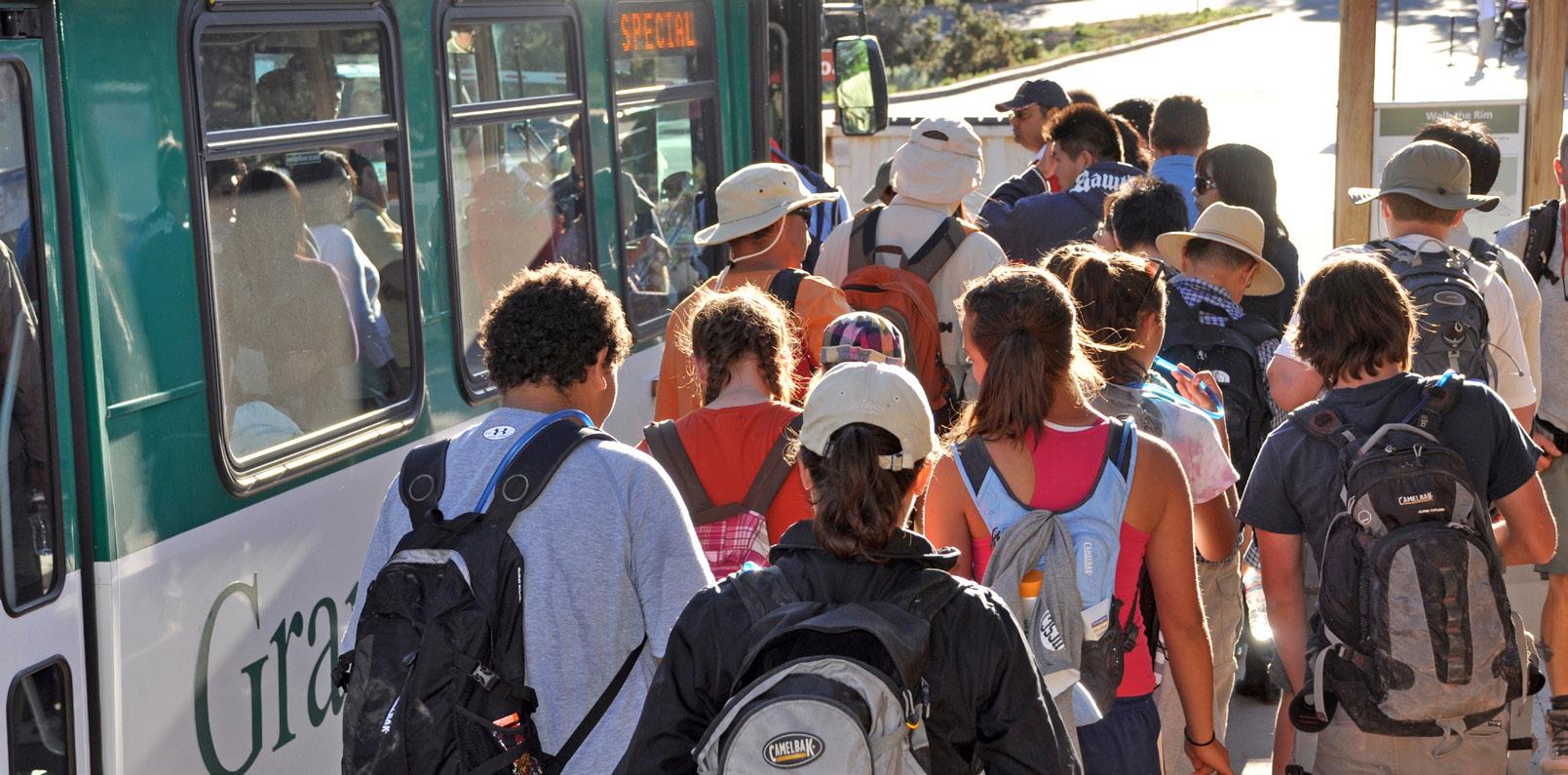

on these important issues was the impetus behind an ambitious 2022 visitation survey project funded by Grand Canyon Conservancy. Led by Dr. Will Rice, Assistant Professor of Outdoor Recreation and Wildland Management at the University of Montana, and Dr. Derrick Taff, Professor in Charge of Graduate Studies Recreation, Park, and Tourism Management at Penn State University, the project’s goal was to gather data from park visitors on their motivations, their experiences, and their perceptions
of resource degradation, to develop effective methods for prioritizing future research and management interventions in at-risk areas. “Grand Canyon is a key pillar of our system of national parks, and our larger system of World Heritage Sites,” notes Dr. Rice, “and therefore it is somewhat surprising how little research has been previously conducted to inform visitor use management in popular day-use locations.”
The research project reflects the deep personal connection that Drs. Rice
12 | CANYON VIEWS
Photos courtesy Will Rice, Ph.D
and Taff have with Grand Canyon National Park. “I was a seasonal ranger in the park in the summer of 2015,” Dr. Rice recalls. “Later, I returned as a Ph.D. student to conduct some of my dissertation work in the park, studying key stakeholders’ perceptions of visitor use management. And returning this past summer, as a professor with students of my own—staying in the same cabin I lived in during my time as a seasonal ranger—I was able to help carry out the very study Derrick and I proposed through my dissertation work.”
That earlier project, which was conducted in 2019, involved interviews with park managers, commercial tourism operators, local leaders, community service organizations, and others familiar with the park’s resources and management. It helped to identify which sites in the
park’s South Rim area should be of most concern for future visitor use management and monitoring, including the areas that were the focus of the visitor survey project.

During the summer of 2022, teams from Penn State and the University of Montana surveyed visitors who drove into the park through the South Entrance, as well as pedestrian visitors at the Bright Angel Trailhead, the Village bus transfer, Grand Canyon Visitors Center Orange Route bus transfer, and the path leading to Mather Point. They collected data on visitor demographics and activities, their transportation choices, what they felt they gained from visiting the park, and how crowding and safety concerns impacted their plans and experiences. The study also included a participatory GPS mapping component, giving visitors the opportunity to map sites where they
accessed park services, as well as areas they felt were damaged by overuse or were at risk of future degradation.
The combination of GPS data and survey results was designed to help park managers better understand how visitor motivations relate to actual behavior during their visits. “Combining spatial data from GPS units given out to visitors moving around the park with survey data will give us a really comprehensive picture of who is visiting the most accessible areas of the park, how often they spend there, and how they are distributing through the area,” observed Elena Thomas, a University of Montana master’s student who served on a survey team. “Given that most visitors never leave the South Rim of the canyon, this data is essential to park management to provide visitors with the best possible experience.”
13
Areas of Concern for the management of recreational ecosystem services as defined by the multiplied overlap densities of Service Provisioning Areas and either degraded or at-risk areas. From: “Identifying recreational ecosystem service areas of concern in Grand Canyon National Park: A participatory mapping approach” by William L. Rice, B. Derrick Taff, Peter Newman, Katherine Y. Zipp, Bing Pan.
To help determine visitors’ motivations for recreating in Grand Canyon National Park, survey participants were asked about the perceived benefits of their visits in several key areas:


• Connection with nature— including whether their activities at the park deepened their connection with nature and their appreciation of natural beauty.
• Physical and mental well-being— including whether their visit reduced mental and physical stress, increased their selfacceptance and self-esteem, and boosted their confidence in their abilities and their sense of independence.
• Family cohesiveness—including whether their park experience strengthened family bonds, kept any children in their group engaged in the outdoors, and bolstered their socialization and social identity.
• Appreciation of Grand Canyon— including whether their outing enhanced their knowledge of Grand Canyon’s cultural heritage, their understanding of historical sites, and their knowledge of the canyon’s geologic history.
To determine the impact of crowding on visitor experiences, survey participants were also asked whether they planned or altered their itinerary to avoid crowds—including decisions to visit the park earlier or later than they would have liked—as well as how crowded they felt during their visit. In addition, the survey solicited visitor feelings regarding their own physical safety in the park, including the
perceived risk from vehicles, crowds, dangerous behavior by other visitors, wildlife, the proximity of trails to the edge of the canyon, and heat and other weather conditions. They were also asked whether they had decided not to travel to certain areas of the park due a fear of injury, and whether their perception of safety at the park would influence future trip planning.
14 |
CANYON VIEWS
In total, the teams collected 599 surveys and GPS tracks at the study’s four pedestrian survey locations, with another 354 surveys and GPS tracks collected from vehicles entering the park through the South Entrance. Most survey respondents indicated that their primary activity during their visit was hiking, followed by photography and scenic driving, and many said that their main motivation for engaging in those activities was to be close to nature, view wildlife, and have fun with family. After their visit, participants were asked what level of success they had in accomplishing their desired outcomes, with the most common results including improving their mood and stimulating their senses through experiencing nature. Visitors were also asked about their overall affinity for Grand Canyon, with most agreeing “that no other place could compare to the experience they have at this place.”

The survey data will help to provide park managers with the information
they need to make service and resource allocation decisions to enhance visitor experiences while protecting Grand Canyon National Park’s natural and cultural resources. “I got to help answer questions park managers had about their visitors who were coming to enjoy the canyon, what their motivations for visiting were, where they traveled during their time in the park, and if they attained positive outcomes from their trip,” says Sophie Morris, a University of Montana master’s student who was part of a survey team. “While it was not on many visitors’ trip itineraries to be asked about taking a GPS unit along with them or completing a survey, we had a lot of positive responses and interest in what we were doing and why.”
While the researchers are still analyzing the data collected this past summer, they are confident that their work will help Grand Canyon National Park manage its natural resources, essential infrastructure, and cultural
and historical sites to keep the park healthy and vibrant for generations to come. “It is heartening as a researcher to be able to work with staff at the park who are so dedicated to science-based decision-making and management,” declares Dr. Rice. “The greatest feeling as a researcher is knowing that the science you are conducting is going to be applied to inform and improve management. At Grand Canyon, that is without question. Derrick and I look forward to continued collaboration with the park.”
This groundbreaking visitation survey project is set to continue in 2023, with the researchers shifting their focus to six other areas of concern in the park. “We’re hoping to be back in the park conducting research this coming summer, focusing on Mather Campground and the overlooks along Desert View Drive,” says Dr. Rice. “The entirety of South Rim is just too big to cover in one year.”
15

16 | CANYON VIEWS
Photo by Chad Moriarty, winner of the GCC membership card photo contest

17
The Canyon is Listening: Á-mi-i-evyo, “Yes, I hear you!”
The scent of burning sage wafts upward, alerting nearby hikers that something special is happening on Gthatv He’e (Coyote Tail, a.k.a. Bright Angel Trail). The melodic sound of chanting echoes off the canyon walls. Havasupai religious practitioner Uqualla is in the midst of a pilgrimage from the South Rim to Havasupai Gardens. Those lucky enough to be close by are witnessing the embodiment of a spiritual calling that is reconnecting Uqualla and the Havasupai people to their ancestors’ traditional farming lands.
“The Havasupai are the guardians of the master altar—the canyon,” says Uqualla, “and the canyon is a constant communicator to everyone who comes into it. Gway-miganavgé means ‘It is telling you something’ in
Supai. This is the foremost statement of our tribe.”
Uqualla spent each month of 2022 making full moon hikes into the canyon to give prayers, songs, and gifts to the ancestors at Havasupai Gardens.

“I had a sense that something had to be done . . . our reservation in Supai had been closed during COVID and ancestral energy was coming through to me, telling me I need to remind the guardians, my tribe, of the responsibility that has been gifted to them,” he says.
His vision told him that he would have twelve moons, and in each he would go into the canyon at a cycle opening, when the energies of the spirits are at their widest field of traveling between earth and sky. And so, every full moon
in 2022, Uqualla made his walking pilgrimage, awakening the spirits of his ancestors with every step. In 2023, he will continue these journeys once each season.
His sister, Dianna “White Dove” Uqualla, says that it’s important to keep the knowledge of the Havasupai people who lived and thrived in the canyon. “In years past, we have been forgotten, but our family was there from the beginning,” she says.
For thousands of years, the Havasupai (People of the Blue Green Waters) have lived in Grand Canyon, occupying what is now known as the South Rim, with scattered bands of families living and farming where Havasupai Gardens is located. In the years following the establishment
Uqualla during a pilgrimage to Havasupai Gardens. Photo courtesy NPS
of Grand Canyon National Park, the Havasupai were forcibly evicted from their homes and restricted to an area known as Supai Camp. Uqualla’s pilgrimages mark a renewed relationship between the Havasupai and the lands they were forcibly removed from by the National Park Service in the 1920s.
In 2022, the park sought a formal name change request with the United States Board of Geographic Names (USBGN) to rename Indian Garden as Havasupai Gardens. This was approved in November 2022, and work has commenced to update signage, literature, and educational programming.
“The renaming from Indian Garden to Havasupai Gardens is out of respect for the undue hardship imposed by the park on the Havasupai people,” said Grand Canyon National Park Superintendent Ed Keable.
Uqualla says that his presence in the canyon energetically imbues the trail with his ancestral medicinal forces.


“I am an ambassador, a sentinel of their bloodline lineages,” he says. “I am representing my heritage and the canyon appreciates that.”
Uqualla and White Dove encourage visitation to Grand Canyon National Park, as long as guests respect the land they are walking on.
Says Uqualla, “This canyon is placed here for the well-being of all that come to it. It is important that the moment you step into the canyon on the trails, not just the rim, that you give a request for protection and watch before you make that first step.”
He explains that every step we take on a trail in the canyon, we must be filled with good heart intention, so the canyon embraces us and fills us with the information of the ancestors.
“Come and be a part of it. Just be in a heart integrity. Step in. Give it an offering. Hopefully people will be a little more respectful in a personal place. It is your organic understanding of what you are stepping into.”
“I ask permission. I desire your watch. To care for me, to teach me as I walk down into the canyon. This I did. And as we arrived here into Havasupai Gardens—a beautiful area where the water flows, where the grass is green, where the tree people are in watch— there was a calling for ceremony. Not for us, but for the ancestors. They have not seen a ceremonial procession come down this canyon in many decades, and this is something that should be done continuously. We arrived here in Havasupai Gardens, to drink of its waters, to sing to the waters, to allow the smoke to rise from the medicine plants, to do that blessing, that divination.” —Uqualla
19
Photos: Left, Dianna “White Dove” Uqualla. Above, Uqualla. Photos courtesy NPS
News and Updates
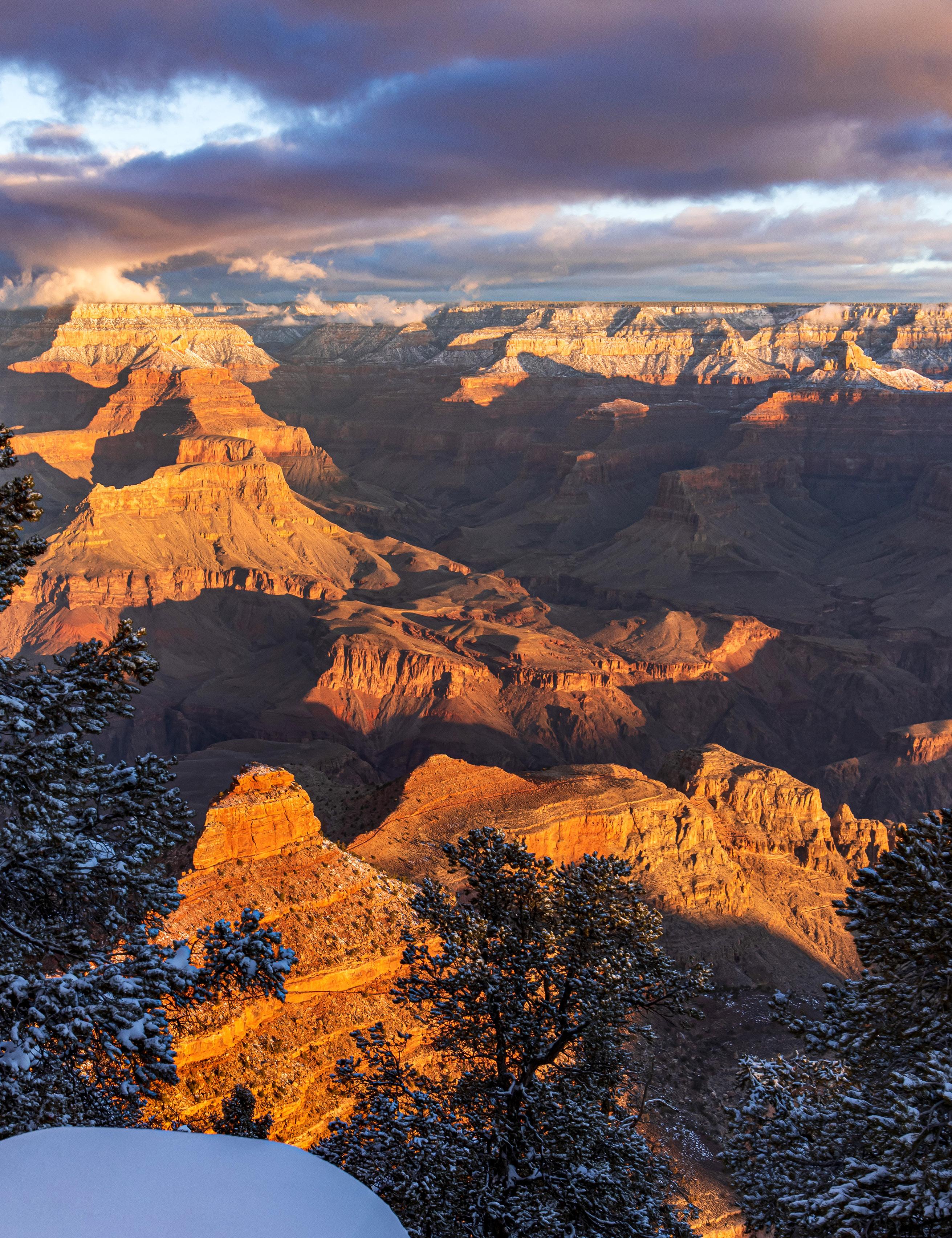
20 | CANYON VIEWS
Desert View Progress
This past summer, the park celebrated the groundbreaking of the construction project at the Desert View Inter-tribal Cultural Heritage Site. Phase 1 of this project included refurbishing the Desert View Amphitheater and the Tribal Welcome Center.
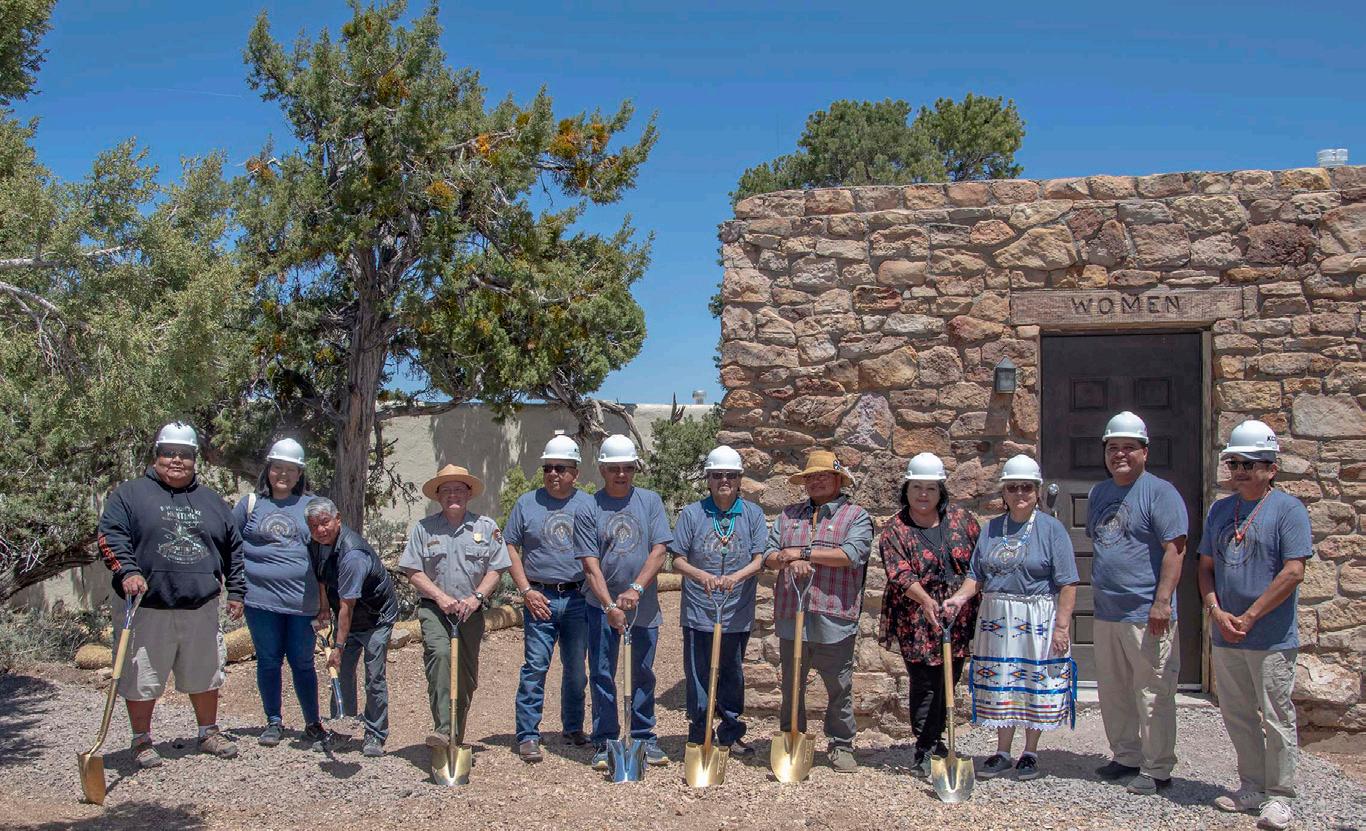


Uqualla of the Havasupai Tribe opened the groundbreaking ceremony with a tribal blessing prayer. The participants then moved to the nearly completed amphitheater for remarks from Grand Canyon Conservancy (GCC) CEO Theresa McMullan, members of the Inter-tribal Working Group (ItWG), and Superintendent Ed Keable. A group from the Hopi Tribe provided a corn dance for the assembly, and the event concluded with a groundbreaking at the welcome center.
Grand Canyon National Park’s and GCC’s work with the ItWG on this project is transformational. We are working together to make it known, far and wide, that Grand Canyon is the home of Indigenous people. Collaboration is ongoing to create opportunities for first-voice interpretation in the park, for cultural demonstration, and for Native arts and crafts vending at Tusayan Museum. Phase 2 will shift some of the parking spaces and will provide other landscape changes.
Grand Canyon is leading the way in the National Park Service for engaging with our tribal neighbors toward the goal of welcoming them back into their home with respect. Stay tuned for more updates as the project continues.
21
Photos courtesy NPS
Grand Gathering Returns
After a two-year hiatus during the pandemic, GCC held its first in-person Grand Gathering in the park this past June. Grand Gathering is our members-only event that provides updates on priority projects GCC supports at Grand Canyon National Park.

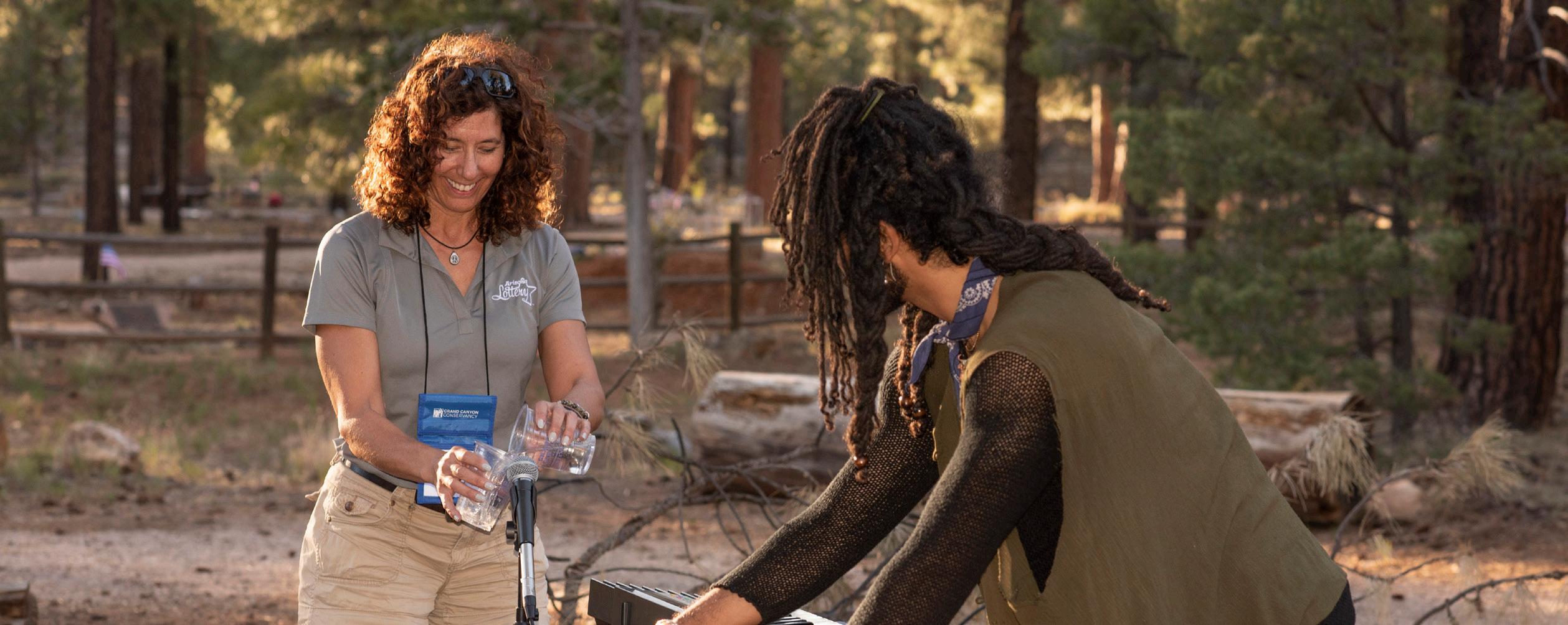
65 GCC members attended the events that began with a social get-together and information forum. Staff from the park’s Visitor and Resource Protection, Preventive Search and Rescue, and Science and Resource Management (SRM) division’s Wildlife and Archaeology work groups staffed information tables and talked to members about the various programs their donations support.
Artist in Residence Elijah Jamal
Asani brought members outside the Shrine of the Ages, where he collaborated with them to create a
“soundscape” of Grand Canyon. Our members were very engaged, and talented too! The unique sounds they made were layered together to create one song of the canyon.
Later that evening, Ranger Rader Lane provided the keynote address, talking about the Dark Skies program and the Star Party, which was taking place the same week.
Saturday morning was a great opportunity for members to interact with Superintendent Ed Keable and GCC CEO Theresa McMullan during a question-and-answer session. The park’s geosciences resource manager, Mark Nebel, and Chief of Interpretation, Todd Stoeberl, made presentations that provided meaningful details about SRM’s work with LiDAR (Light Detection and Ranging) and the breadth of the Interpretation and Resource Education Division’s programs, respectively.
On Saturday afternoon, GCC members traveled to Desert View, where GRCA and GCC staff introduced them to the new amphitheater and discussed what the future will bring at the new Inter-tribal Cultural Heritage Site. Cultural demonstrators were operating in the Watchtower and staff were walking the site, interacting with GCC members, and providing updates for the area.
It was wonderful seeing some of our members in person once again!
Be on the lookout for your invitation to this year’s Grand Gathering, which will take place on the South Rim June 9–10.
Photos courtesy NPS/Veronica Tierney
Hollywood Comes to the Canyon
The actors Jean Smart and Hannah Einbinder came to Grand Canyon National Park last winter to film a scene from Season 2 for the HBO series “Hacks.” The production team applied for and received a permit to film at Desert View.



The National Park Service and Grand Canyon National Park allows filming and photography when it is consistent with public enjoyment and protection of park resources. Filming is encouraged when it is for the specific use of the park, aligns with strategic park goals, or when it assists the NPS in fulfilling its mission. The Office of Communications, Partnerships, and External Affairs processes film permits in the park and monitors the productions to ensure legal compliance.
The park’s film permitting and monitoring program is coordinated by Joelle (Jo) Baird. Jo has more to do than just hang out with stars! She had to jump into action when it became apparent that one of the activities in the scene would have violated the Superintendent’s Compendium had it been real. One of the plot points was for Einbinder’s character to scatter the “ashes” of a deceased character over the railing into the canyon. Superintendent Keable banned this practice last year because it was culturally insensitive to our Indigenous neighbors who believe the canyon and its waters are living entities. The spreading of human remain ashes is therefore inappropriate, and now, unauthorized. The substance the actor disposed of into the canyon was benign organic matter, not human remain ashes. Jo nevertheless quickly negotiated a disclaimer with the executive
producer that educates viewers to the cultural issue and that people are no longer authorized to dispose of human remain ashes in the canyon.
Superintendent Keable came out to watch the filming, and in his words, “To meet Jean Smart!”
Photos courtesy NPS
Assessing Juniper-Woodland Health in Grand Canyon National Park
Baylee Christensen, Polk Vegetation Intern, Grand Canyon Conservancy
Juniper stress and die-back has been a growing concern across the Southwestern U.S. and has been observed specifically in central and northern Arizona. Drought is thought to be the main cause for mortality; however, juniper trees are typically considered drought tolerant, so water intake isn’t a main indicator for die back (Linton, 1998). A more recent study shows precipitation was not found to be correlated with dieback but is rather related to interactions with temperature, water conductivity, and elevation (Kannenburg et al, 2021). There is still a need to assess what environmental factors impact juniper tree die off. Regardless of the cause, the first step of this is to actualize where juniper woodlands have been impacted at Grand Canyon National Park (GRCA). This was the purpose of a ground-truthing project begun in spring 2022 by GRCA and NASA DEVELOP that uses National Agriculture Imagery Program (NAIP) images to identify sites of stressed juniper woodlands within GRCA (Jackson et al. 2022). Looking forward, utilizing satellite imagery to monitor vegetation could help with future climate assessments.
Grand Canyon National Park is home to many species of juniper trees, which have multiple ecologic, cultural, and economic roles. The juniper woodlands provide crucial habitat for insects and wildlife, prevent soil erosion, retain water in the hydrologic system, and help maintain ecosystem nutrient availability. Culturally, juniper trees are a highly regarded resource and have been for centuries. Heat, fuel, medicinal properties, caloric supplementation, and a wide
spectrum of other uses make this tree greatly respected.
NASA DEVELOP provided the Vegetation Program with 15 potential sites that could indicate juniper woodland stress and/or mortality. To promote accessibility, the sites provided were located within 800 meters (2,624 feet) of a road. Data from the Grand Canyon National ParkGrand Canyon/Parashant National Monument vegetation classification and mapping project (Kearsley et al. 2015) was used to identify locations across the park where juniper is a significant component of the vegetation assemblage. In July 2022, we selected four sites within an accessible distance to evaluate and collect the data.

At each site, we installed a transect to assess 10 juniper trees per site,
then we gathered the coordinates and an azimuth at the beginning of a transect. We gathered data on each tree that included tree height and width, percent die off in each section of the tree, overall green percentage, and mortality agents observed.
This was the first year we gathered data, therefore, conclusions regarding juniper tree dieback are still being developed. Of personal interest was how only three of the 40 trees assessed showed new growth. And, out of the 40 trees surveyed, 28 had less than 50 percent green foliage. Also, some juniper trees showed stress despite not having an obvious causal agent, such as juniper mistletoe (Phoradendron juniperinum) and/or insect predation. It can be documented that while both pinyon pine and juniper trees were present on each plot, pinyon pine had a near
24 | CANYON VIEWS
NASA DEVELOP sites selected for monitoring (Jackson et al. 2022).
dominant canopy cover, and showed great mortality. At the time, the project was not set up for gathering dieback statistics on pinyon pine, so this needs to be further studied during site assessments to compare mortality among pine and juniper species more accurately. Also, a larger quantity of site assessments is recommended for this project to improve the accuracy of data collection.

Upon further follow up, this project can enable park managers to better
References
understand how forests are responding to a variety of environmental conditions and anticipate how plant and animal communities may be impacted. Juniper dieback is a growing concern among ecologists in the Southwest and die off could be another indicator of ecological consequences.

To learn more about the project, readers can view the NASA Develop StoryMap at “The Root of the Cause” online at storymaps.arcgis.com. This project was made possible by
Jackson, S., Hitchner, M., Ritchie, M., and Miotke, J. 2022. Using NASA Earth Observations to Monitor and Model Juniper Woodland Mortality in Grand Canyon National Park. NASA Develop. Fort Collins, Colorado.
Kannenberg, A. Steven, Driscoll, Avery W., Malesky, D., Anderegg, William R.L. (2021). Rapid and surprising dieback of Utah juniper in the southwestern USA due to acute drought stress, Forest Ecology and Management, Volume 480, 2021, 118639, ISSN 0378-1127, https://doi. org/10.1016/j.foreco.2020.118639.
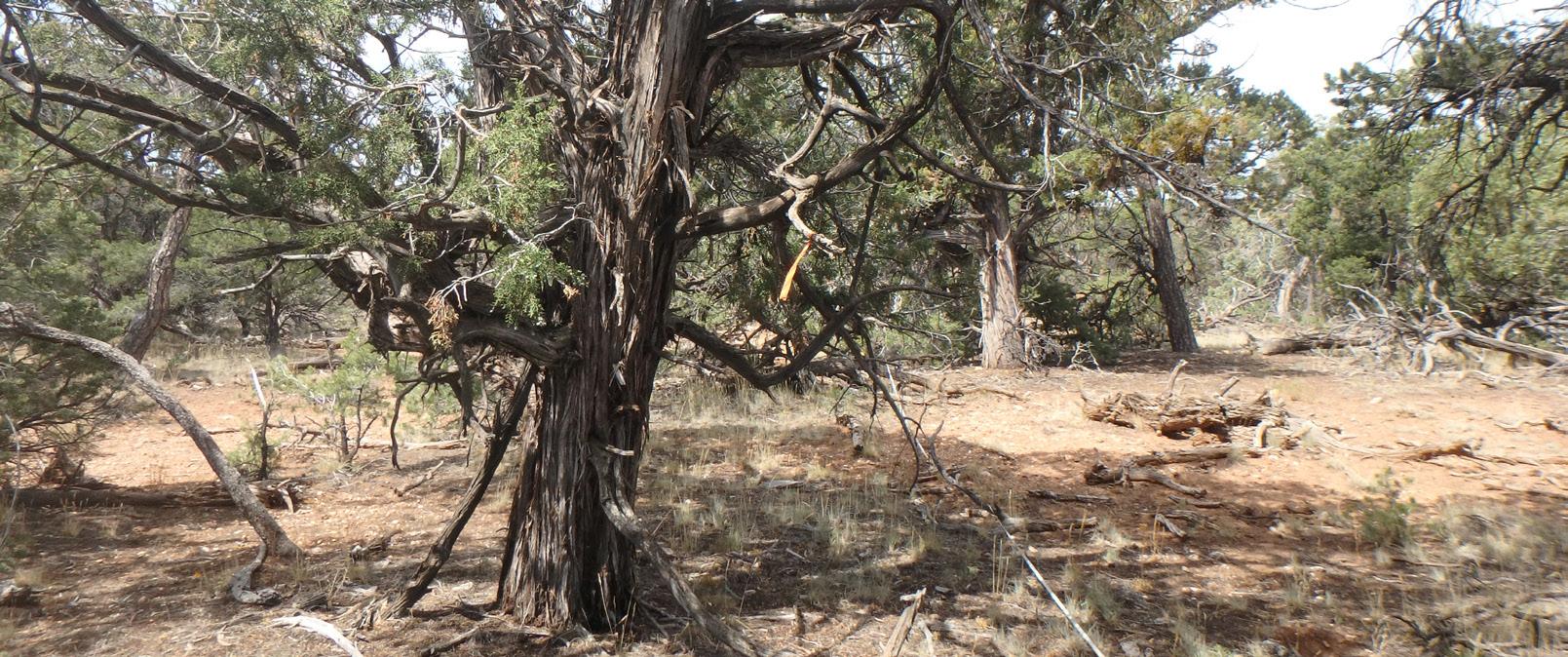
a culture of communication and partnership. Generous funding was provided by GCC through the Polk Fellowship Fund. The USFS, Southwest Region provided handson training and their data collection expertise. The Vegetation Program at GRCA helped facilitate the project and provided the vast number of resources required for such a project. Special thanks to GRCA Biological Science Technicians Tania Guardado and Tara Chizinski, who helped collect data and orient me.
Kearsley, MJ, et al. (2015). Grand Canyon National ParkGrand Canyon/Parashant National Monument vegetation classification and mapping project. Natural Resource Report. NPS/GRCA/NRR—2015/913. National Park Service. Fort Collins, Colorado.
Linton, M. J., Sperry, J. S., & Williams, D. G. (1998). Limits to water transport in Juniperus osteosperma and Pinus edulis: implications for drought tolerance and regulation of transpiration. Functional Ecology, 12(6), 906-911. https://doi.org/10.1046/j.13652435.1998.00275.x
25
Photos courtesy NPS
A juniper tree (Juniperus osteosperma) on site 6.
Baylee Christensen (intern) getting ready to take the diameter at the root collar of the tree.
A transect established on site 6.
Take a Journey of Discovery with the Field Institute
Grand Canyon Conservancy’s Field Institute (GCCFI) has a brand-new slate of exciting classes and tours lined up for 2023!
From half-day rim tours to 18-day river trips, GCCFI’s unique offerings will highlight Grand Canyon’s amazing culture, wildlife, geology, and history. You’ll learn from those who know the canyon best—geologists, historians, ecologists, archaeologists, and other experts—who will help you gain a deeper connection to Grand Canyon.
Some highlights for 2023 include:
CONNECT
Take a Navajo-led tour of the Colorado Plateau that will highlight the Indigenous connection to the land.
CHALLENGE
Explore and discuss water issues in the West on a rigorous hike into the depths of the canyon. Relax with an easy mindfulness hiking trip based along the rim.
DECOMPRESS
We look forward to seeing familiar faces and can’t wait to introduce new visitors to the wonders of Grand Canyon!
To learn more or to make your reservations, visit grandcanyon.org or email gccfi@grandcanyon.org.
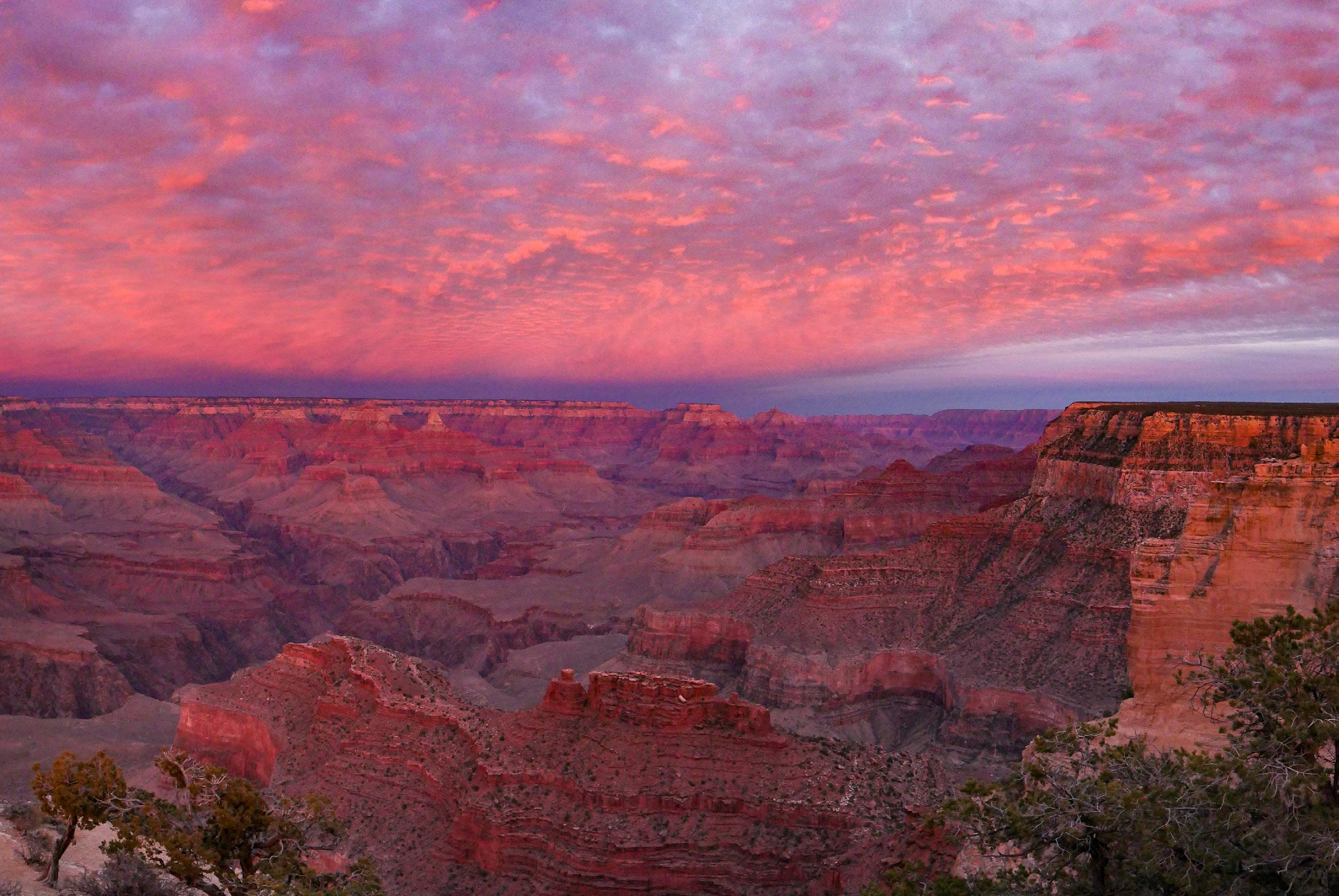
26 | CANYON VIEWS
Photo courtesy NPS
Artist and Astronomer in Residence Updates
Artists and Astronomers in Residence at the South Rim from 2021 and 2022 share where they are now, and how their residencies at Grand Canyon National Park affected them.
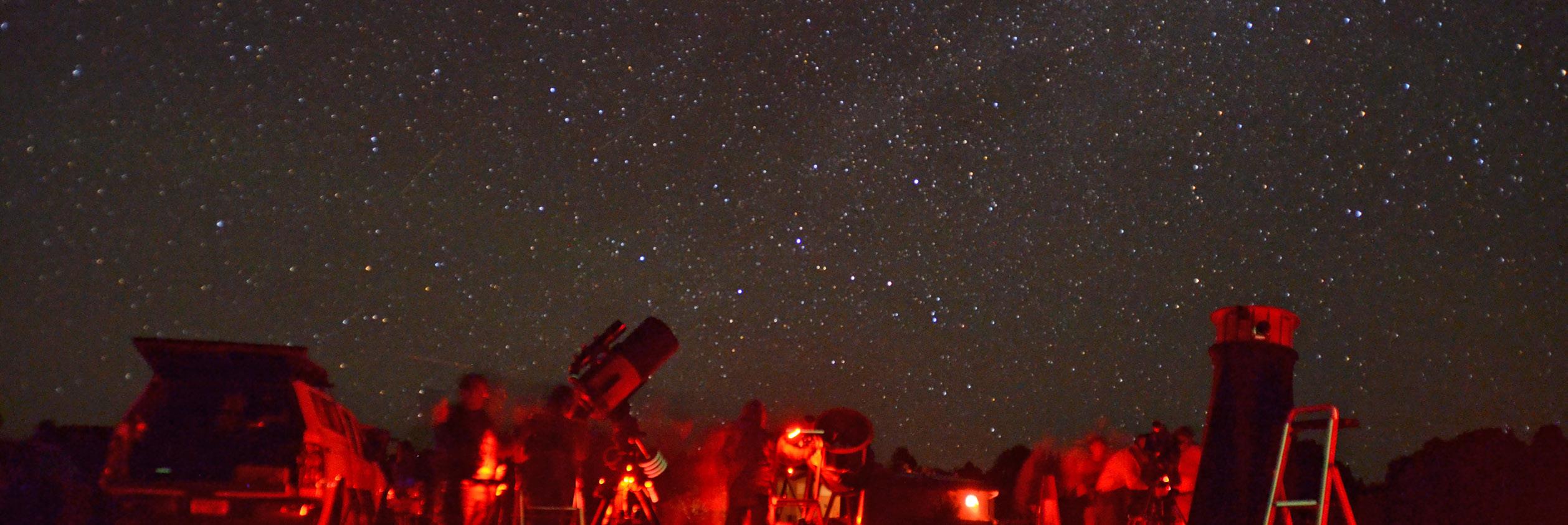

Heather Johnson: Visual Artist, Writer, Traveler
 Artist in Residence, May–June 2021, heatherljohnson.com
Artist in Residence, May–June 2021, heatherljohnson.com

and has evolved into a line of bags and clothing made from salvaged, repurposed fabric. Stitched into each piece are embroidered references to nature and human infrastructural technology, the same references that appear in my drawings, installations, and mixed media works.
Alongside this, I’ve been building a new body of collages and installations that reflect upon experiences and observations from different places, including Grand Canyon. I exhibited some of this work at BoxoPROJECTS in Joshua Tree, California, this past winter.
What have you been up to since you were in residence at the canyon?
My residency took place during the height of the COVID-19 pandemic, when we were all contending with lockdowns and a heightened lack of predictability in daily life. When I returned, I realized I needed to create a sustainable means of living that would address climate change and the need for COVID safety, while creating a new way of expressing and disseminating the ideas that influence my non-commercial artwork. So, I launched “Artificial Heart,” my wearable art brand. It started with embroidered, hand-made face masks
How did the Grand Canyon residency influence your work?
During my residency I became fascinated with the Transcanyon Waterline that delivers the only source of potable water to the park’s North and South Rims. For me, this project symbolizes human ingenuity and frailty, in contrast to much of the nature it enables us to experience— juniper pine trees surviving for centuries on little water, or the 2-billion-year-old basement rocks nearly as old as the earth itself, for instance—that quietly outlive us in the face of our own struggles. A 3-day solo hike, by way of an especially dangerous and difficult trail,
revealed to me the depths of my own strength and vulnerability too. These experiences and observations imprint everything I make right now.
What’s your favorite part of the canyon?
The Grandview Trail—it should have killed me but didn’t. And the National Park and GCC people who undertake the incredible myriad tasks required to keep Grand Canyon accessible to all. I have profound respect especially for those who do the arduous and dirty work of maintaining the pipeline and the park’s other unsung essentials, like the composting toilets, sewage treatment plants and power lines.
Photo courtesy NPS
Heather Johnson
“Dead or Alive,” mixed media, by Heather Johnson
Dr. Tyler Nordgren: Artist, Astronomer, Night Sky Ambassador

Astronomer in Residence, June–July 2021, SpaceArtTravelBureau.com
What have you been up to since you were in residence at the canyon?
Since serving as Grand Canyon’s first Astronomer in Residence in Summer 2021 I have led astronomy-themed trips to far-flung locations where I connect the destination to the wider universe around us. In the past 12 months I traveled to Antarctica to see a total solar eclipse from the ice flows, saw a total lunar eclipse from the Galapagos Islands, and was the astronomy guide on a ten-day commercial rafting trip through Grand Canyon carrying an 8-inch telescope through the rapids during a period of moonless nights when the Milky Way was high overhead.
How did the Grand Canyon residency influence your work?
My residency in summer 2021 was my first trip since the beginning of the pandemic and it reaffirmed my love of talking to the public about how places like Grand Canyon allow you to see so far into the universe and back in time. When I was asked to be the astronomer on a commercial rafting trip through Grand Canyon in September 2022, I made frequent comparisons to what we saw and did on the rim to what we could see and do on the river.
What’s your favorite part of the canyon?
I love the river running through Grand Canyon.
Erin Reynolds: Choreographer, Dancer, Lecturer, Educator

Artist in Residence, September–November 2021, erinreynoldsdance.com
What have you been up to since you were in residence at the canyon?
Since my residency at GCC I have continued teaching at several California universities, have created, and presented several new dance works, and have continued my research with Heather Barker and the Immersive Design Research Lab on ways dance interacts with public space through new media. Highlighted works include Femme #6 in collaboration with writer Jae Towle at the Crocker Art Museum, a feature on the LBC Dance Mosaic Mural for the Long Beach Reality Challenge, and a showing of “The Sum of One’s Parts” (the film created during my GCC residency) at various small galleries and art shows.
How did the Grand Canyon residency influence your work?
The Grand Canyon residency influenced my work in more ways than I could say. One particularly influential mode was in its ability to validate dance as an integral method for stewarding the transformation of space into place, broadening people’s understandings of land to include perspectives of body. As I have continued my work as a choreographer, the people around me seem more aware and inspired by the power the body has in influencing decisions of land and space.
What’s your favorite part of the canyon?
The North Rim in the fall! I am so grateful to all who helped me in getting there during my residency as its memories will stay with me and my work forever.
Erin Reynolds
Dr. Tyler Nordgren setting up the telescope for a night of stargazing in the canyon.
Lauren Camp: Poet Laureate, Artist, Educator
Astronomer in Residence, August–September 2022, laurencamp.com

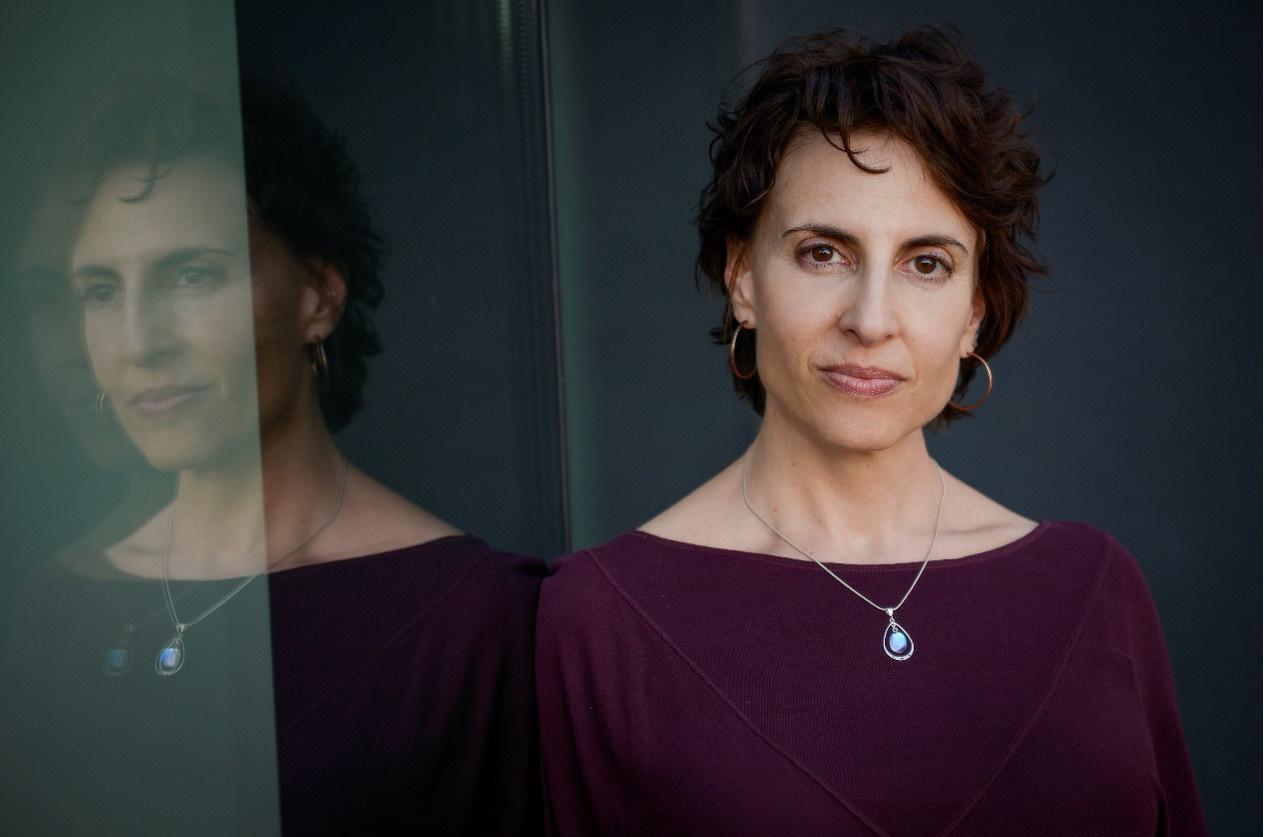
What have you been up to since you were in residence at the canyon?
Within a week of returning to my home, I began a new appointment as Poet Laureate of New Mexico. This is a three-year term, designed to raise awareness of poetry around the state and to amplify the voices of our poets, as well as residents who don’t yet know that poetry can include them. It was a whirlwind re-entry into a very exciting new role after a magical and immersive month at the rim.
How did the Grand Canyon residency influence your work?
I was deeply inspired at the canyon and drafted many poems. I always write from place, or into place— using my location to help me situate in emotions or memory. Since I was at Grand Canyon as Astronomer in Residence, I determined my place was, at least in part, the sky. This gave me a clear (and new) focus. I tasked my poems with holding this exponentially large sphere in a variety of ways. I also used the time to learn as much as I could about celestial phenomena and light pollution.
What’s your favorite part of the canyon?
I was awed at every turn, but my favorite part was time of day, rather than place: the canyon at sunset as it moves into true dark.
For information on 2023 Artists and Astronomers in Residence, please visit grandcanyon.org.


29
Lauren Camp, photo by Bob Godwin
Lauren Camp reading by red light under the dark skies of Grand Canyon. Photo by Ed Neubaum
Member Spotlight: Lynn and Dave Rahn
Lynn and Dave Rahn of Newport Beach, California, first heard about Grand Canyon Conservancy (GCC) when Dave was planning to do a river rafting trip down the Colorado River. “A friend told me that I had to read a book about John Wesley Powell’s exploration of the Colorado River, and the only place I could find it was on the GCC website,” said Lynn. “After I bought it, I started receiving information from GCC, and was impressed that something as simple as buying a book introduced us to the work that was being supported by the Conservancy.”
The retired couple had been long-time philanthropists, supporting works like Crystal Cove Conservancy’s restoration of the cottages at Crystal Cove State Beach in Southern California, and Lynn had a background in foundation and nonprofit work.
An email about GCC’s work on Indigenous Affairs and the Desert View Inter-tribal Cultural Heritage Site tugged at the Rahn’s hearts, and they were impressed with how the project was being managed.
“We learned about GCC’s goal to close out a matching fundraising campaign, ending in a few days, that would rebuild the Desert View site to feature the canyon’s tribes who would relay their stories to park visitors,” they said. “The combination of site improvements and the long-term educational interpretive impacts really resonated with us. After talking with GCC staff and realizing that they are truly a great team capable of making the project a reality, we agreed to close out the campaign.”
Helping to finish a goal was impactful to the couple, and they are thrilled that their contribution will help assure that future visitors enjoy and learn about
Grand Canyon in partnership with the tribes that call Grand Canyon home.
Later, when Dave was at the canyon for his river rafting trip, he met with GCC staff and was given a tour of Kolb Studio and Desert View, further impacting his commitment to the Conservancy.
“It was amazing!” he said. “I was able to see things I wouldn’t have ordinarily. I walked up inside the Desert View Watchtower and it solidified that we had made a good decision.”
Lynn and Dave also attended the 2022 Grand Gathering at the South Rim, where they were impressed with how much they learned, and then came back to the park for the 2022 Celebration of Art, where they
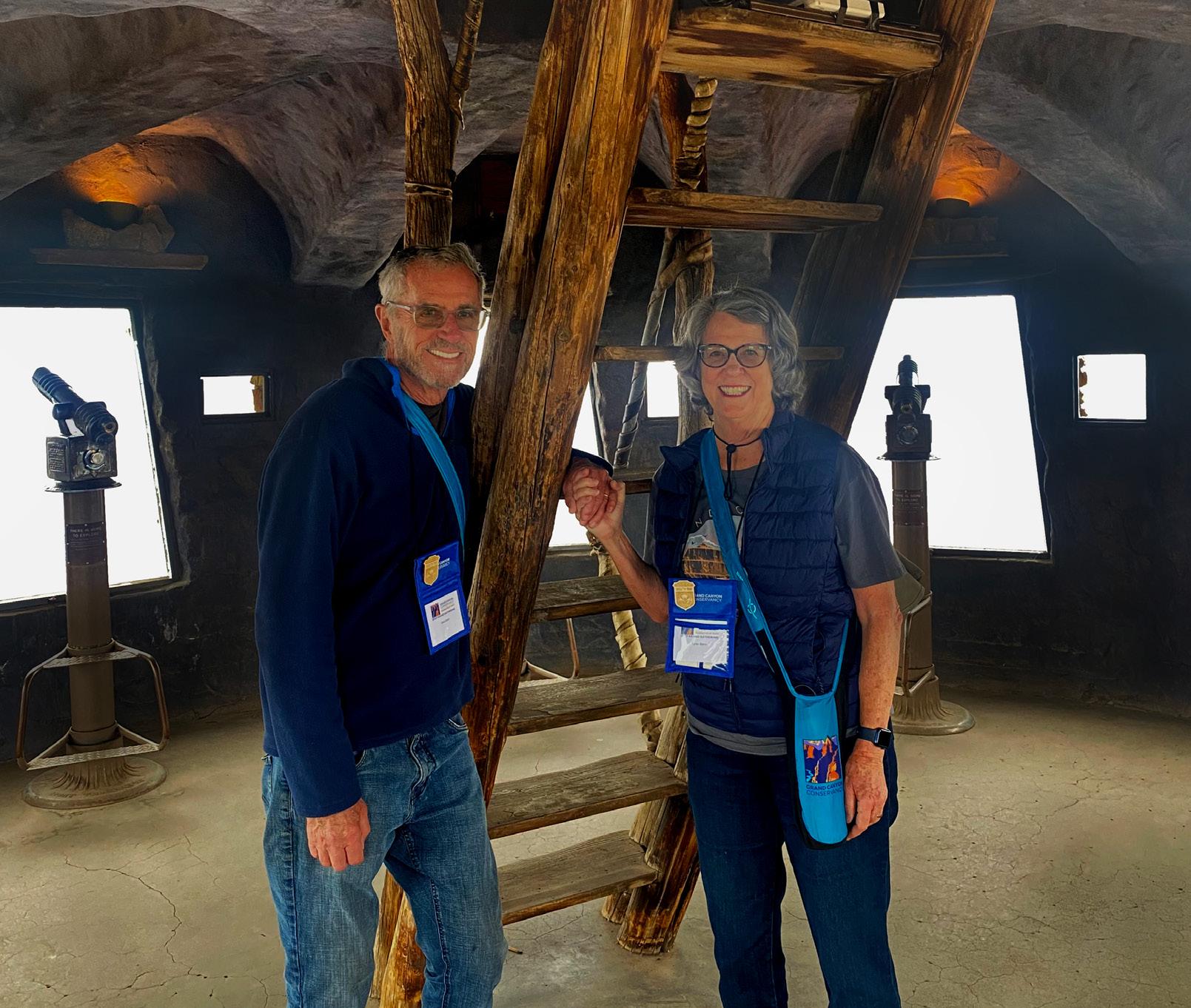
purchased two paintings that now hang on their walls at home.
“I believe in the National Parks, and know they need support all the time,” said Lynn. “Growing up, my family and I camped at many of the National Parks in California, and when we came to Grand Canyon, what hit me was walking the Rim Trail at sunset. I watched the colors change and thought, oh my, I didn’t realize how beautiful it is.”
Adds Dave, “For us, it is a ‘pay it forward,’ so others can learn just like we did with our parents in our youth and with our own family over decades of camping, overnighting at Phantom Ranch, completing Rim-to-Rim hikes, and rafting down the Colorado River.”
30 | CANYON VIEWS
The Rahns at Desert View Watchtower. Photo by Lynn Donahue
Membership: Bringing You Closer to the Canyon
Your membership supports ongoing endeavors at Grand Canyon National Park that shape the future of this land for generations to come. Thank you for helping us fund important projects like: the continuous upkeep of the corridor trails; cultural heritage and historic preservation; educational programs; the protection of the Colorado River, vegetation, and wildlife; dark skies; and the amplification of the canyon’s Indigenous voices.
As a member, you’ll receive exciting benefits including:
• Invitations to members-only events and experiences
• The monthly e-newsletter, Call of the Canyon
• Canyon Views, our members-only magazine
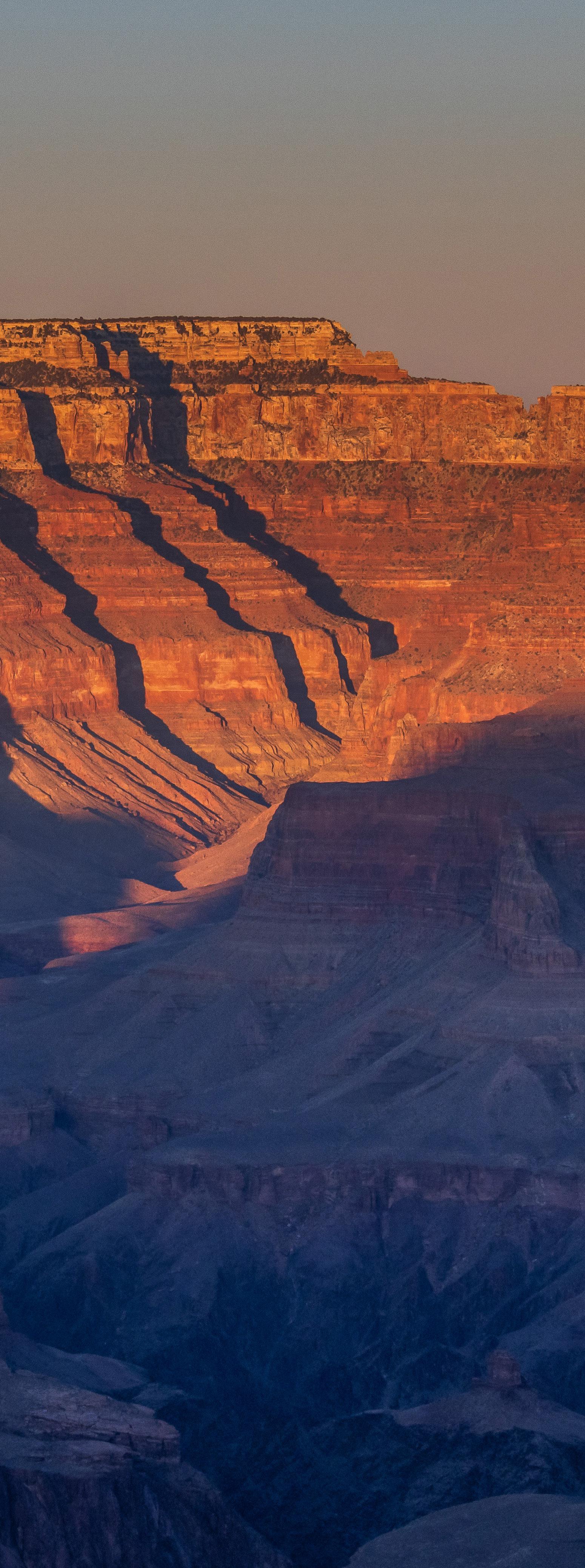
• Either a digital or physical membership card (your choice!)
• A 15% discount in GCC Stores at the park and online
• Discounts at other participating Public Lands Alliance stores around the country (over 400 nationwide)
And as a Grand Guardian ($1,000/year) or above, you’ll also receive:
• Priority registration for Grand Gathering and Celebration of Art
• Early access to registration for Field Institute classes
• Acknowledgment on digital displays in the Visitor Center and our Visitor Center Store
• Recognition in our Annual Report
• A dedicated Grand Guardian members phone line
• Invitations to our Insights and Impacts virtual talks with GCC’s CEO and Grand Canyon National Park Leadership
• Invitations to our quarterly Canyon Conversations virtual series with special bonus content for Grand Guardians
31
Photo courtesy
NPS
Become a Grand Guardian!
If you are interested in supporting Grand Canyon National Park while having opportunities to meet park leadership, rangers, firefighters, artists, and astronomers and deepening your support of our mission, consider becoming a Grand Guardian.

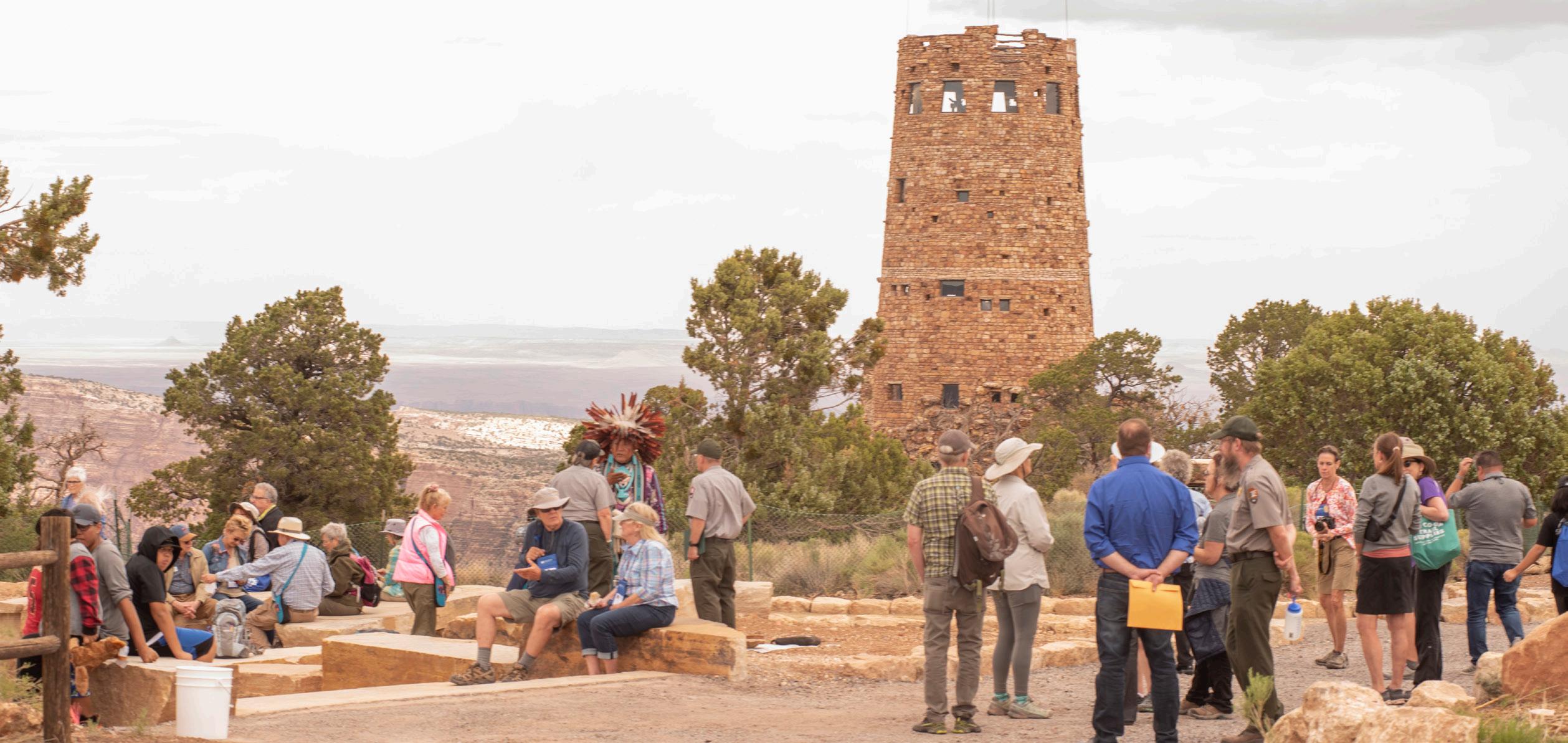

Your gift of $1,000 or more will make an immediate impact on the park you love. And the best benefit of all is knowing that you support America’s only Natural Wonder!
For questions about becoming a Grand Guardian, please contact Lynn Donahue at ldonahue@grandcanyon.org or (928) 556-5298.
2023 Event Dates
Grand Gathering
June 9–10, 2023
Celebration of Art
September 1, 2023–January 15, 2024
32 | CANYON VIEWS
James McGrew twilight painting. Photo by Terri Attridge
Photo courtesy NPS
SHOP GRAND CANYON CONSERVANCY

Shopping GCC’s stores supports Grand Canyon National Park, and GCC Members receive 15% off!

$30
Be the envy of your friends out on the trail while wearing this on-trend trucker hat emblazoned with a gorgeous image of Grand Canyon. Created by Wild Tribute, which was founded to honor our national parks and public lands. The company donates 4% of its proceeds to protect wild places.
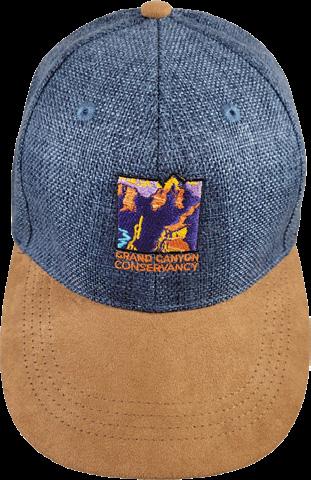

$25
Show your Membership pride by sporting this navy faux linen with saddle faux suede bill hat. Featuring the iconic Grand Canyon Conservancy logo.
$45
Keep cozy and warm with this 100% recycled microfiber
$25
The Tribal Medallion, a collaboration between National Park Service staff and our tribal partners, was developed by Andy Dufford of Chevo Studios to introduce park visitors to the Indigenous cultures that maintain strong cultural and spiritual ties to the canyon. The original medallion can be seen near Mather Point.
5)
This ceramic mug includes a spill resistant lid with slide action and a cork base. The central theme of the canyon is seen in the stair steps in the center. The stars represent the constellations, the water symbols remind us of the ongoing importance of rain and water in the desert southwest, and the hand is a reminder of all who have come this way before.

$20
This 1,000-piece puzzle features poster art for 18 different locations within the boundaries of the Colorado Plateau. Made of recycled paper, the finished size is 14” x 39” and a free reference poster is included.

$30
Stay hydrated while showing your support for GCC! The bottle has a double steel wall and holds 25 oz. of liquids.
 1) Grand Canyon Ladies Landscape Mesh Back Cap
2) Grand Canyon Conservancy Logo Cap
3) Grand Canyon Geometric Plush Blanket
polyester/fleece blanket.
4) Tribal Medallion Tote Bag
Tribal Medallion Mug with Lid $20
6) Peaks, Plateaus, and Canyons of the Colorado Plateau Puzzle
7) Grand Canyon Conservancy Logo Water Bottle
1) 2)
3)
6)
4)
5)
1) Grand Canyon Ladies Landscape Mesh Back Cap
2) Grand Canyon Conservancy Logo Cap
3) Grand Canyon Geometric Plush Blanket
polyester/fleece blanket.
4) Tribal Medallion Tote Bag
Tribal Medallion Mug with Lid $20
6) Peaks, Plateaus, and Canyons of the Colorado Plateau Puzzle
7) Grand Canyon Conservancy Logo Water Bottle
1) 2)
3)
6)
4)
5)
33
7)
GRAND CANYON CONSERVANCY


P.O. BOX 399, GRAND CANYON, AZ 86023
WE INSPIRE GENERATIONS OF PARK CHAMPIONS TO CHERISH AND SUPPORT THE NATURAL AND CULTURAL WONDER OF GRAND CANYON.
grandcanyon.org
EDUCATE. PROTECT . | PLEASE RECYCLE
INSPIRE.












 Photos
Photos







































 Artist in Residence, May–June 2021, heatherljohnson.com
Artist in Residence, May–June 2021, heatherljohnson.com


















 1) Grand Canyon Ladies Landscape Mesh Back Cap
2) Grand Canyon Conservancy Logo Cap
3) Grand Canyon Geometric Plush Blanket
polyester/fleece blanket.
4) Tribal Medallion Tote Bag
Tribal Medallion Mug with Lid $20
6) Peaks, Plateaus, and Canyons of the Colorado Plateau Puzzle
7) Grand Canyon Conservancy Logo Water Bottle
1) 2)
3)
6)
4)
5)
1) Grand Canyon Ladies Landscape Mesh Back Cap
2) Grand Canyon Conservancy Logo Cap
3) Grand Canyon Geometric Plush Blanket
polyester/fleece blanket.
4) Tribal Medallion Tote Bag
Tribal Medallion Mug with Lid $20
6) Peaks, Plateaus, and Canyons of the Colorado Plateau Puzzle
7) Grand Canyon Conservancy Logo Water Bottle
1) 2)
3)
6)
4)
5)

